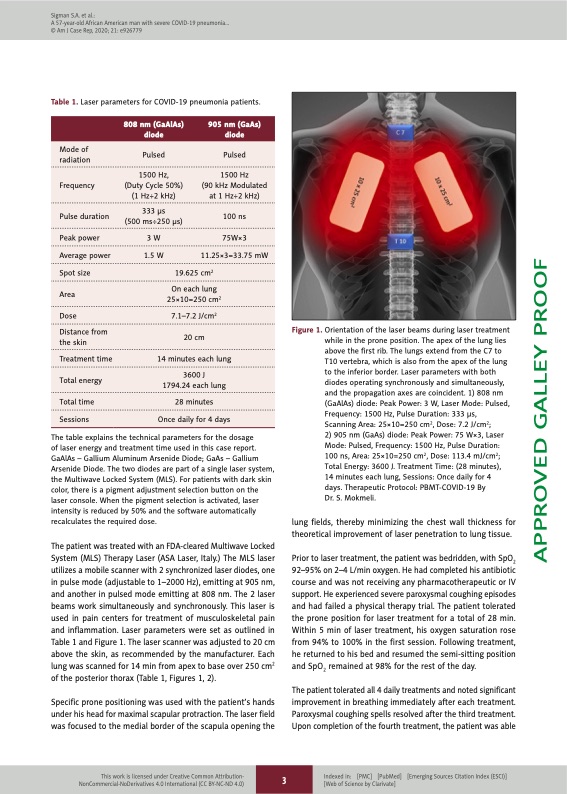
PDF Publication Title:
Text from PDF Page: 003
Sigman S.A. et al.: A 57-year-old African American man with severe COVID-19 pneumonia... © Am J Case Rep, 2020; 21: e926779 Table 1. Laser parameters for COVID-19 pneumonia patients. 808 nm (GaAlAs) diode 905 nm (GaAs) diode Mode of radiation Pulsed Pulsed Frequency 1500 Hz, (Duty Cycle 50%) (1 Hz÷2 kHz) 1500 Hz (90 kHz Modulated at 1 Hz÷2 kHz) Pulse duration 333 μs (500 ms÷250 μs) 100 ns Peak power 3W 75W×3 Average power 1.5 W 11.25×3=33.75 mW Spot size 19.625 cm2 Area On each lung 25×10=250 cm2 Dose 7.1–7.2 J/cm2 Distance from the skin 20 cm Treatment time 14 minutes each lung Total energy 3600 J 1794.24 each lung Total time 28 minutes Sessions Once daily for 4 days The table explains the technical parameters for the dosage of laser energy and treatment time used in this case report. GaAlAs – Gallium Aluminum Arsenide Diode; GaAs – Gallium Arsenide Diode. The two diodes are part of a single laser system, the Multiwave Locked System (MLS). For patients with dark skin color, there is a pigment adjustment selection button on the laser console. When the pigment selection is activated, laser intensity is reduced by 50% and the software automatically recalculates the required dose. The patient was treated with an FDA-cleared Multiwave Locked System (MLS) Therapy Laser (ASA Laser, Italy.) The MLS laser utilizes a mobile scanner with 2 synchronized laser diodes, one in pulse mode (adjustable to 1–2000 Hz), emitting at 905 nm, and another in pulsed mode emitting at 808 nm. The 2 laser beams work simultaneously and synchronously. This laser is used in pain centers for treatment of musculoskeletal pain and inflammation. Laser parameters were set as outlined in Table 1 and Figure 1. The laser scanner was adjusted to 20 cm above the skin, as recommended by the manufacturer. Each lung was scanned for 14 min from apex to base over 250 cm2 of the posterior thorax (Table 1, Figures 1, 2). Specific prone positioning was used with the patient’s hands under his head for maximal scapular protraction. The laser field was focused to the medial border of the scapula opening the Figure 1. Orientation of the laser beams during laser treatment while in the prone position. The apex of the lung lies above the first rib. The lungs extend from the C7 to T10 vertebra, which is also from the apex of the lung to the inferior border. Laser parameters with both diodes operating synchronously and simultaneously, and the propagation axes are coincident. 1) 808 nm (GaAlAs) diode: Peak Power: 3 W, Laser Mode: Pulsed, Frequency: 1500 Hz, Pulse Duration: 333 μs, Scanning Area: 25×10=250 cm2, Dose: 7.2 J/cm2; 2) 905 nm (GaAs) diode: Peak Power: 75 W×3, Laser Mode: Pulsed, Frequency: 1500 Hz, Pulse Duration: 100 ns, Area: 25×10=250 cm2, Dose: 113.4 mJ/cm2; Total Energy: 3600 J. Treatment Time: (28 minutes), 14 minutes each lung, Sessions: Once daily for 4 days. Therapeutic Protocol: PBMT-COVID-19 By Dr. S. Mokmeli. lung fields, thereby minimizing the chest wall thickness for theoretical improvement of laser penetration to lung tissue. Prior to laser treatment, the patient was bedridden, with SpO2 92–95% on 2–4 L/min oxygen. He had completed his antibiotic course and was not receiving any pharmacotherapeutic or IV support. He experienced severe paroxysmal coughing episodes and had failed a physical therapy trial. The patient tolerated the prone position for laser treatment for a total of 28 min. Within 5 min of laser treatment, his oxygen saturation rose from 94% to 100% in the first session. Following treatment, he returned to his bed and resumed the semi-sitting position and SpO2 remained at 98% for the rest of the day. The patient tolerated all 4 daily treatments and noted significant improvement in breathing immediately after each treatment. Paroxysmal coughing spells resolved after the third treatment. Upon completion of the fourth treatment, the patient was able This work is licensed under Creative Common Attribution- NonCommercial-NoDerivatives 4.0 International (CC BY-NC-ND 4.0) 3 Indexed in: [PMC] [PubMed] [Emerging Sources Citation Index (ESCI)] [Web of Science by Clarivate] APPROVED GALLEY PROOFPDF Image | A COVID-19 Pneumonia Responded to Photobiomodulation Therapy

PDF Search Title:
A COVID-19 Pneumonia Responded to Photobiomodulation TherapyOriginal File Name Searched:
laser-therapy-severe-COVID-19-case.pdfDIY PDF Search: Google It | Yahoo | Bing
Cruise Ship Reviews | Luxury Resort | Jet | Yacht | and Travel Tech More Info
Cruising Review Topics and Articles More Info
Software based on Filemaker for the travel industry More Info
The Burgenstock Resort: Reviews on CruisingReview website... More Info
Resort Reviews: World Class resorts... More Info
The Riffelalp Resort: Reviews on CruisingReview website... More Info
| CONTACT TEL: 608-238-6001 Email: greg@cruisingreview.com | RSS | AMP |